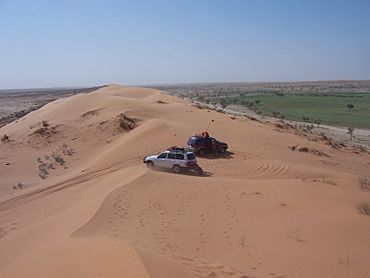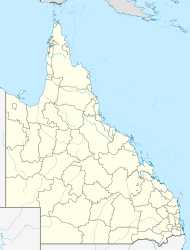Munga-Thirri National Park facts for kids
Quick facts for kids Munga-Thirri National ParkQueensland |
|
|---|---|
|
IUCN Category II (National Park)
|
|

'Big Red' is the largest sand dune in the national park, 2007
|
|
| Nearest town or city | Birdsville |
| Established | 1967 |
| Area | 10,120 km2 (3,907.4 sq mi) |
| Managing authorities | Queensland Parks and Wildlife Service |
| Website | Munga-Thirri National Park |
| See also | Protected areas of Queensland |
Munga-Thirri National Park, once known as the Simpson Desert National Park, is the largest national park in Queensland, Australia. It is located about 1,495 kilometers west of Brisbane. The park covers a huge area of 10,120 square kilometers. You can find it in the Simpson Desert, near a spot called Poeppel Corner. This area is in the western part of Birdsville in the Central West region of Queensland.
Amazing Landforms
The park is famous for its giant sand dunes. Some of these dunes can be as tall as 50 meters, which is like a 16-story building! They are usually about 1 kilometer apart. Most dunes are between 10 and 35 meters high. The longest sand ridge stretches for 200 kilometers.
One of the most well-known dunes is called 'Big Red'. It is located about 35 kilometers west of Birdsville. These impressive dunes started forming around 30,000 years ago. You can also find salt lakes and claypans in the park.
Wildlife and Plants
This unique desert landscape is home to many different animals. You can find up to 180 types of birds here! The park is part of an important bird area. This means it has special habitats for birds like the Eyrean grasswren.
Other animals you might spot include dingos, geckos, and even wild camels. After good rainfall, the park completely changes. Many wildflowers that were sleeping in the dry ground suddenly bloom, making the desert colorful.
Visiting the Park
If you plan to visit Munga-Thirri National Park, it's best to go between April and October. This helps you avoid the extremely hot daytime temperatures. It's also a good idea to travel with at least two vehicles. Make sure you have long-distance communication equipment, as there are no roads in the park.
You will definitely need a 4WD vehicle to travel through the park. The main path is called the QAA Line. Winter mornings can be very cold, but summer temperatures can reach up to 50 degrees Celsius! You can camp within 500 meters of the QAA Line. Remember, vehicles are not allowed to leave the main track.
Park rangers, who are based in Birdsville, sometimes close the park. This happens if flooded rivers make it too dangerous for visitors. More tourists have been visiting, which means wood for campfires is getting harder to find. This can affect native animals. So, park authorities now encourage visitors to use gas camp stoves instead of wood fires.
Park History
Aboriginal peoples have lived in this region for many generations. They knew how to survive in the dry desert. They would dig deep holes called soaks between the dunes to find water. Some of these soaks were 7 meters deep!
The first non-Aboriginal person to cross the central and southern parts of the Simpson Desert was David Lindsay in 1886. Later, in 1936, Ted Colson crossed the entire length of the desert.
The idea for a national park in the desert was first suggested in 1965. This idea came from the National Parks Association of Queensland. The park was made bigger in 1991. The new areas included dry lands with even more types of plants.
As of July 2019, the Head Ranger of the park is Elder Don Rowlands OAM. He is an elder of the Wangkangurru people and a traditional owner. He lives in Birdsville.
See also
 In Spanish: Parque nacional Desierto Simpson para niños
In Spanish: Parque nacional Desierto Simpson para niños


